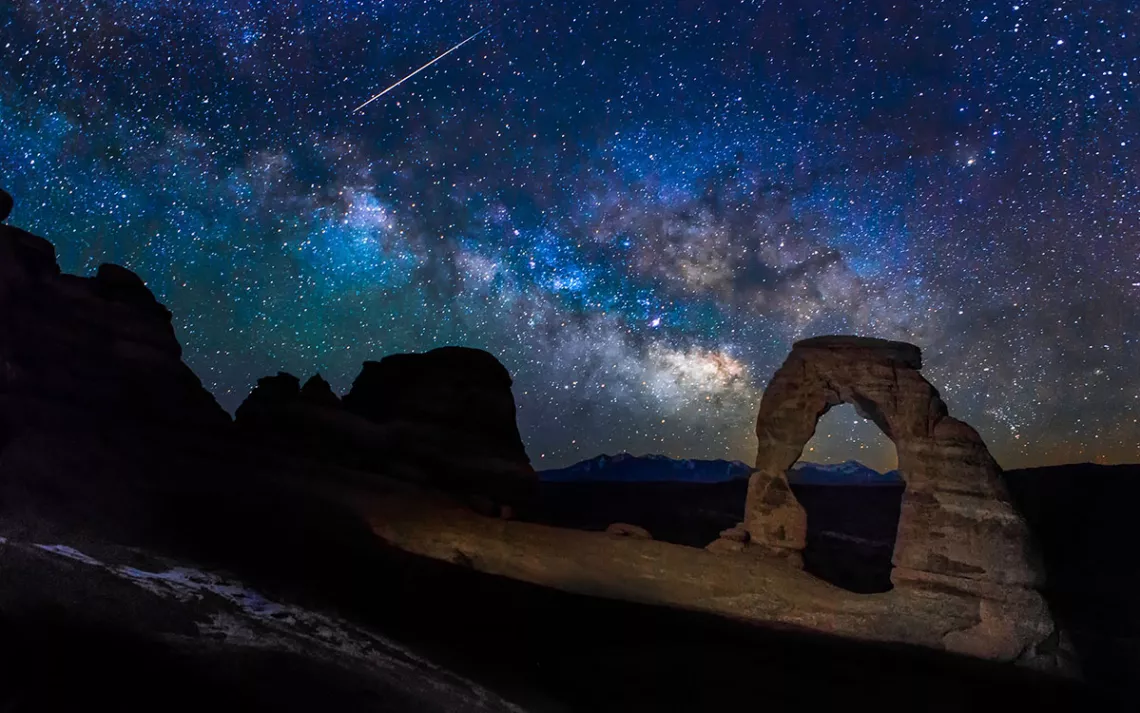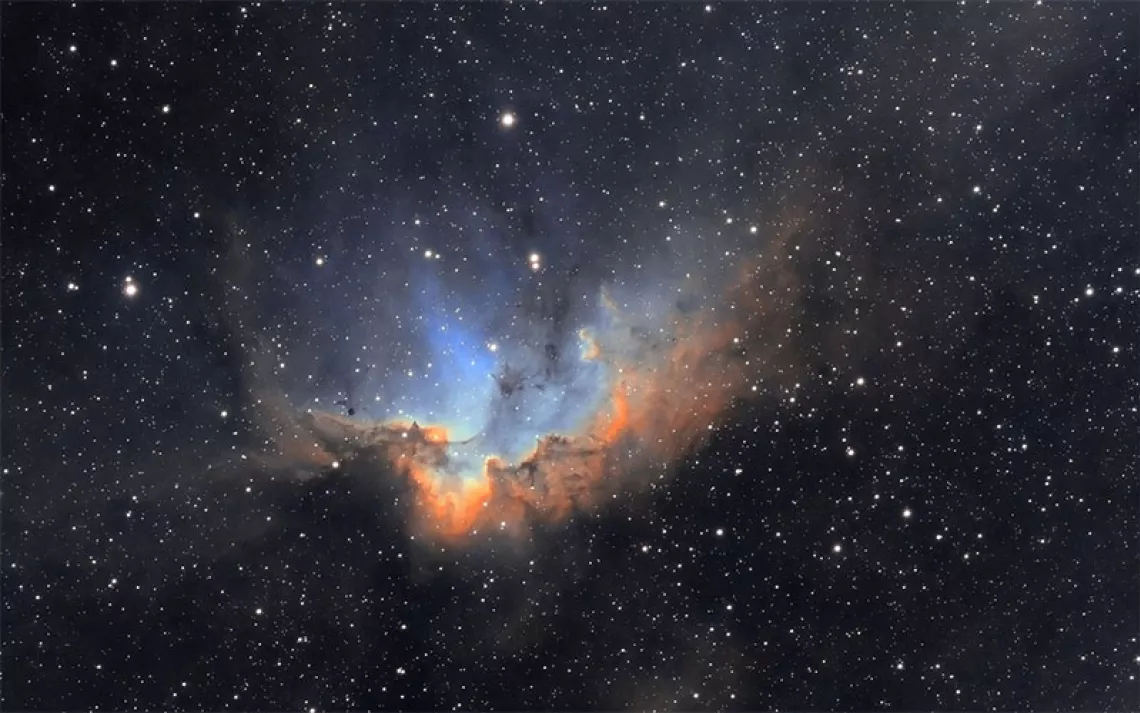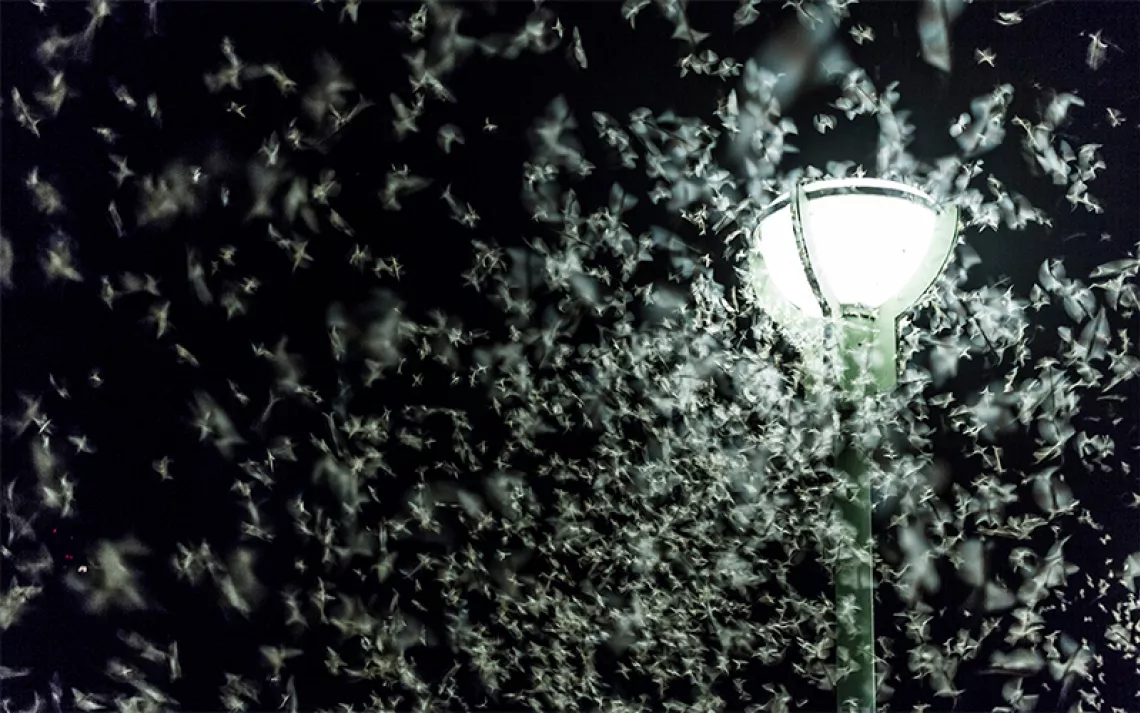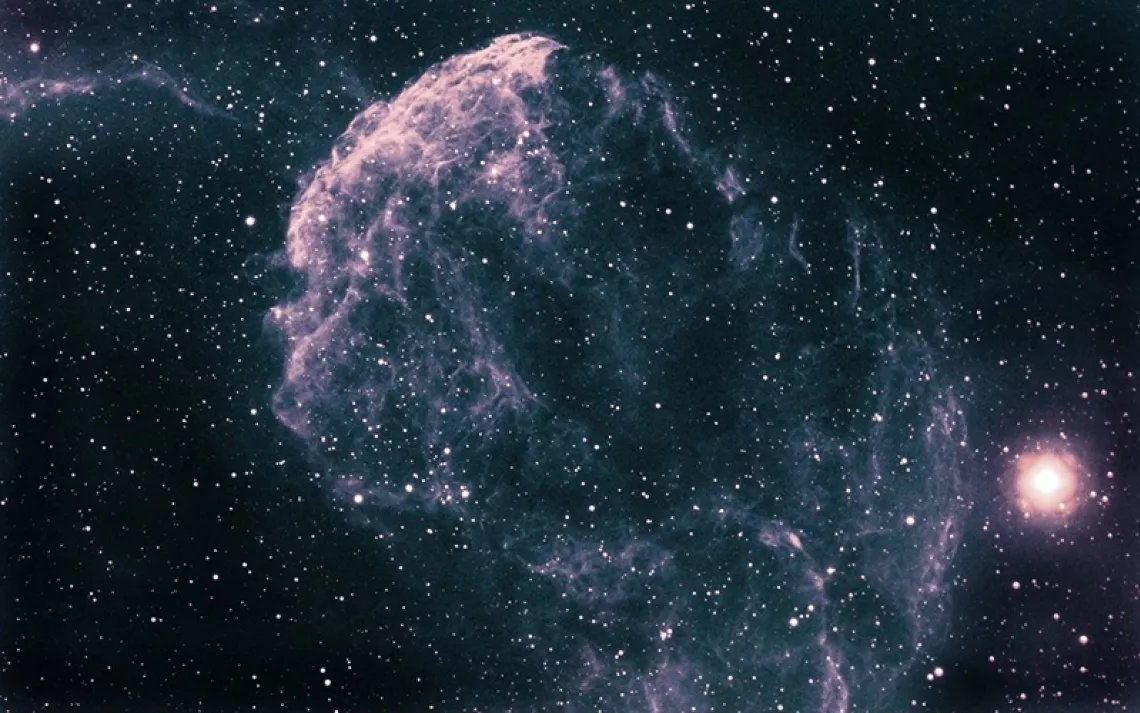Young People Are Losing Their Cultural Heritage to Light Pollution
Constellations and the seasonal information they’ve offered are fading from sight and memory

A meteor, the Milky way, and the Delicate Arch in Grand County, Utah. | Photo by ManishMamtani/iStock
It was a five-hour drive to the stars. That is, a five-hour drive from the suburbs of New Jersey—where the bright glow of my college campus reached into the sky—to the middle of an undeveloped forest in northern Pennsylvania. Far away from city lights, Cherry Springs State Park is one of the best places in the eastern US for stargazing. I was going with my friend Savannah Pobre, a fellow astrophysics student, in the hopes of glimpsing an untarnished night sky.
It was not something I’d seen very often. I was born and raised in a well-populated suburb of Houston, Texas—a sprawling, illuminated city. I could easily count the number of stars I could see on any given night, probably a few dozen at most.
That’s normal for most Americans. Almost everyone in the US lives beneath some degree of light-polluted skies, and a large majority can’t see the Milky Way (the center of our galaxy should appear as a river of stars stretching across the sky). According to a 2023 study published in Science, North American skies are brightening by 10 percent each year. If this trend continues, even the brightest constellations will disappear from view, such as Orion’s belt—a line of three star systems that form a prominent feature of fall and winter skies in the Northern Hemisphere. A child born under 250 stars today will only see 100 by the time they hit adulthood.
Among young people like myself, such diminished views are already the norm. We’re growing up under fewer stars than those seen by generations before us; the full tapestry of the night sky, twinkling planets and all, is something many Gen Zers have never known. Often, it’s something we don’t think to miss.
A week before my trip to Cherry Springs, I was standing outside with another friend on campus. The night was cold and cloudless. We were looking up. There were 30 or 40 stars above us, more than she could see at her home in Brooklyn. She had seen a shooting star once.
“Absolutely crazy,” she said. “I didn’t know that they existed outside of movies.”
I looked at her in surprise. In Texas, I used to drive my parents’ car to nearby fields to watch meteor showers. I made many teenage wishes upon these falling stars.
“That can’t be true,” I responded. Hadn’t she heard of their wishing power? Of that childhood “star light, star bright” rhyme?
She shrugged and laughed a bit, embarrassed by my shock.
“I thought that was just made up,” she said.
DarkSky International is a nonprofit dedicated to protecting dark skies via more responsible outdoor lighting—fixtures with warmer colors, lower wattage, and shields to point the glare downward. This helps protect views of the stars while maintaining street safety. It’s also better for our circadian rhythms, and for the myriad animals who rely on the nighttime environment.
The organization’s volunteer network includes teenagers like Elliot Smith, a senior in high school who lives just outside of Pittsburgh. He didn’t pay much attention to the stars until a few years ago, when a family trip took him an hour away from the city. There, he saw the stars “for the first time properly,” he said. “I wasn’t able to get them out of my head for a while.” The view affected him so much that last summer, through a teen mentorship program at Carnegie Science, he designed shields for outdoor light fixtures. One day, he hopes to turn his model into a reality; he’s started to attend DarkSky meetings, organized locally by volunteer chapters, to gather feedback and ideas for the project.
For most Gen Z dark sky advocates, it took an encounter with true nighttime to realize what they were missing. In addition to experiences like Smith's semi-local family vacation, some went to summer camp, and others took a red-eye flight and looked out the window at a sea of stars. No matter what, it always required some sort of travel, which is not financially or logistically accessible to everyone.
Smith wants to get back that feeling he had on the family trip, but he hasn’t gotten his driver’s license yet. “I want to go to Cherry Springs State Park for my birthday,” he told me. “Have you heard of it?”
When Savannah and I drove to central Pennsylvania in search of the Milky Way, it was a moonless night. We parked the car and crunched our boots through the snow, walking into a field. Above us stretched the stars I came looking for, thousands of them. The galaxy glittered clearly. We fell silent beneath it.
There were other people there, huddled in the biting wind, all looking up. A couple who came to celebrate a birthday, a father and daughter taking long-exposure photos on an iPhone, a group of college students laying on the snow in sleeping bags. They came from New York and Philadelphia.
So many people have begun traveling for proper views of the night sky that there’s now a name for it: astro-tourism. But for millennia, the stars were such a constant presence that people around the world used them to navigate, time their harvests, and tell stories to explain the universe around them.
Ravis Henry is particularly troubled by light pollution’s threat to Indigenous heritage. A Navajo park ranger at Canyon de Chelly National Monument, in the Colorado Plateau, Henry holds close to his heart traditional star stories passed down from elders.
“Our people here around the canyon have always observed the night sky,” he said. “We watch and know what season is approaching, when to start certain ceremonies, when to plant.”
Over the years, Ravis has watched the surrounding area gradually become more developed—not unilaterally a bad thing, he said. He remembers a time when many went without electricity or running water. But he does worry about the future.
“What’s going to happen when they disappear?” he asked. “How are we going to tell our stories? How are we going to show our kids, our grandkids, what we’re talking about?”
Growing up on the North Shore of Oahu, Native Hawaiian Gisele Bisch learned constellations from her family in their backyard. In school, she learned the Hawaiian names for the stars. She also studied her people’s voyaging traditions and how they used the night sky to guide themselves from island to island. Now a junior at suburban Princeton University, she can’t see nearly as many stars, and back home on Oahu the creep of urbanization means she can’t remember a recent time when she had the same view of the night sky that inspired awe in her as a child. She wishes that were different. “Being able to see the stars is a comforting thing,” she said. “It lets me know that I’m home.”
As a park ranger, Henry has seen visitors from metropolitan areas get emotional when the sun sets, having never seen the Milky Way before. “I wouldn’t want any of our kids here in our homelands to have to experience that,” he said. “I wouldn’t want our kids to be gone for so long that when they come home, they shed tears seeing the Milky Way for the first time.” He thinks they should see it all the time, just like their ancestors.
In an effort to encourage protection of the night sky, DarkSky International certifies locations around the world as Dark Sky Places. Some are swaths of land with practically no skyglow, such as remote national parks and islands. Others are cities like Flagstaff, Arizona, a leader in outdoor lighting policy. Many of these sites emphasize the preservation of traditional knowledge in their mission, for example the !Ae!Hai Kalahari Heritage Park in South Africa, ancestral home to the ǂKhomani San and Mier communities.
So far, the list includes over 200 places in 22 countries, in total covering an area of land roughly the size of Florida. DarkSky hopes to grow the list.
“That connection to the night sky, when you take that away, what’s going to happen to us as Navajo people?” Ravis asked. "What’s going to happen to us as human beings?”
 The Magazine of The Sierra Club
The Magazine of The Sierra Club



